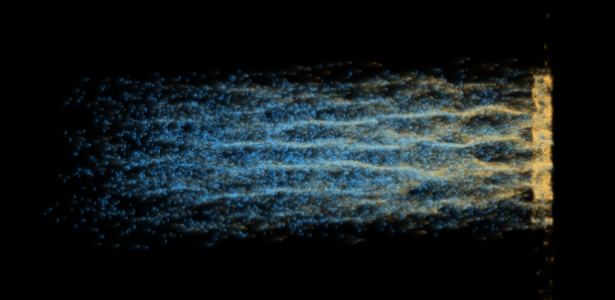運算河流
伏流演化
The Sub Pteron
賴威漢
Wei-Han Lai
The Sub Pteron (Wing、Venation),Pteron是希臘語的翅膀,現在也被用在翼手龍或翼手目上,蝙蝠也隸屬在這個目中,但這不是一個常見的字,sub想作為前綴指作品中河流水道在汲取後在地下流動,伏流本身也是一種不在視覺所見範圍內的下層水流,這個作品名想組合出演算出來的翅膀與皮膜是從水道造型所構成的。
《伏流演化》靈感源自蝙蝠的生態適應性,牠們透過器官演化來適應環境變遷,人們則透過工具的發展以因應外在變化。
作品運用水文開放資料與遞迴演算法,模擬水流網絡的動態構築,將頭前溪與周邊水道比擬為蝙蝠翅膀的骨幹與皮膜。此動態網絡以年度數據作為演化迭代單位,使水流路徑與蝙蝠展翼的形態相互疊合。透過這場演化推測,作品呈現了一種非人類物種在人們進行水資源競爭的變遷中進行適應的過程。
The Sub Pteron (Wing, Venation). Pteron is the Greek word for “wing,” from which the words “Pterodactylus” and “Chiroptera” are derived. Bats belong to the order Chiroptera. However, “Pteron” is not a commonly used word. “Sub” here is used as a prefix, referring to the rivers and waterways in the work that flow underground after being diverted. A subterranean river is a kind of an underground flow that is hidden from sight. The title of this work is a combination representing the idea that the wings and patagia are derived from the morphology of the water network.
The Sub Pteron is inspired by the adaptive behavior of bats, which evolve their organs to survive environmental shifts. In parallel, humans develop tools to navigate changing surroundings.
This work uses hydrological open data and recursive functions to simulate a dynamic water network and align the networks to bat wings and patagia. In this speculative evolution, the work depicts how it adapts to transformations driven by human competition for and allocation of water resources.
洄鄉
Echo-me
呂思函 Szu-Han Lu
音樂製作 | 杜彥豪 DC Tu
植物素材提供 | 陳以荷 Yi-He Chen
物種素材提供 | 吳致怡 AB WU
《洄鄉》以人與魚等物種的身影交織,牽動彼此,表現一種「是人非人,是魚亦非魚」的物種融合,彷彿一種無形的力量在所有生命中悄然流動,交錯成共生的網絡,意欲傳達洄游與回鄉的過程不僅是動植物的本能,也包含人類對源頭的回歸與尋找。
本作品以抽象輪廓勾勒物種型態,並於都市之景及水光之隙緩慢行走的行列表現物種「洄鄉」,影像如水波般延展,傳遞回溯源頭的力量。當觀眾站立於作品前,他們將成為這場討論的一部分,透過裝置偵測觀眾、於畫面中生成新角色,而後與物種行列一同前行,象徵人類歷史與自然的共融與延續。
Echo-me interweaves the silhouettes of humans and fish, merging them into a fusion of species that is “human but not human, fish but not fish.” It conveys an invisible yet powerful force that flows quietly through all of life, intricately intertwining them into a network of co-existence. The work aims to express the idea that migration and return are not merely instincts in animals and plants but also reflect humanity’s search for and return to its origins.
Using abstract contours to outline the forms of species, the work depicts their “homeward migration” as they slowly traverse the urban landscape and shimmering waters. The visuals extend through a rippling effect, symbolizing the force of returning to their origins. When viewers stand before the work, they become part of this discussion—the installation detects their presence and generates new on-screen characters that join the procession of species. This symbolizes the integration and continuity of human history with nature.
意識中的頭前溪
River in Flow
蔣皓任
Hao-Ren Jiang
人的意識連成一片,在更高維的尺度匯聚。凡是被關注的對象,便形成相應的投射物,融入群體的思緒之中。
頭前溪在整治前曾是寬達兩公里的辮狀河流。根據大眾於數位平台留下的紀錄,我們想像那段昔日風采,回溯並推測那段未被完整記載的歷史。
Human consciousness merges into a unified field, converging within higher-dimensional space. Any presence that garners attention transforms into a corresponding projection, seamlessly joining the collective mind.
Before channelization efforts, the Touqian River once meandered as a braided flow nearly two kilometers wide. Drawing on records shared by the public via digital platforms, we envision its former grandeur, retracing and speculating on that chapter of history which remains incompletely documented.
